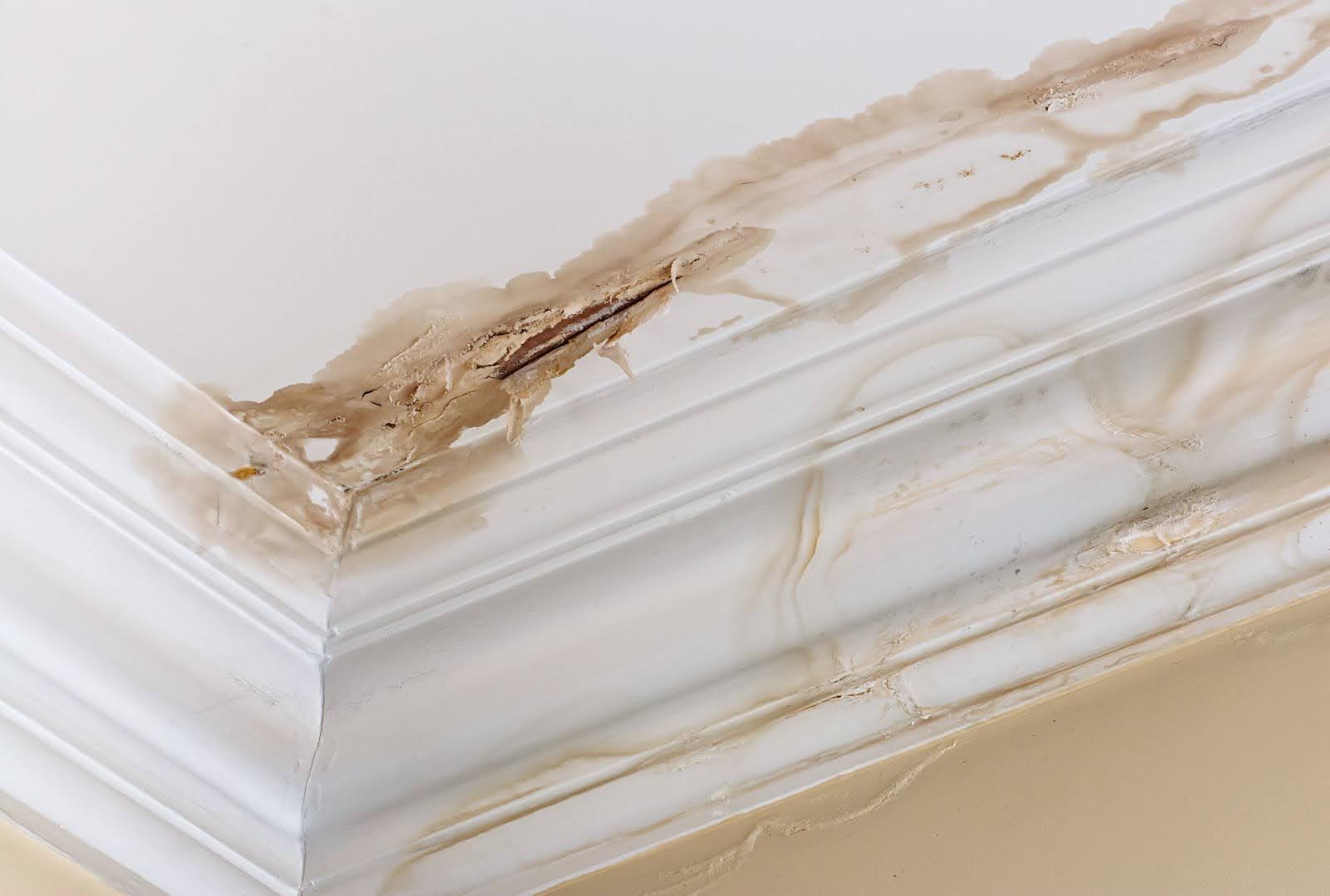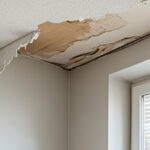Water damage can range from a slow, out-of-sight leak to a sudden disaster that soaks walls, ceilings, and floors. But what is water damage exactly? At its heart, it is simply any and all unwanted moisture that weakens a structure, leading to stains, mold damage, and even expensive structural decay.
Some signs of water damage are fairly easy to identify – like a sagging ceiling or unsightly peeling paint – while others remain hidden behind walls. Water damage under floors is also a common issue.
Early signs of water damage in walls include bubbling wallpaper, musty smells, and damp drywall, while signs of water damage on ceilings usually appear as ominous, dark stains or sagging plaster. Catching these warning signals early can mean the difference between a minor, inexpensive fix and an incredibly costly restoration if the water damage is severe enough.
Throughout this guide, we will explain how to identify signs of water damage before addressing how to diagnose and repair water damage before it gets out of control.
Water Damage in Walls and Ceilings | Overview
Water damage doesn’t always declare itself with dramatic leaks or instantly collapsing drywall. In most (but certainly not all) cases, the first clues are quite subtle and easily overlooked until the problem has spread.
Early signs of water damage in walls may appear as peeling or bubbling paint, soft drywall, or faint stains slowly creeping across the surface. These warning signals strongly suggest moisture is collecting where it shouldn’t, which could mean a hidden water leak or maybe just poor ventilation.
A distinctly musty odor is another obvious red flag. If a room smells damp despite regular cleaning, there’s a pretty good chance that moisture is trapped inside the walls or ceilings. Mold after water damage, even in quite small amounts, should never be overlooked. Once mold takes hold, it spreads unforgivingly and can cause both structural damage and serious health issues.
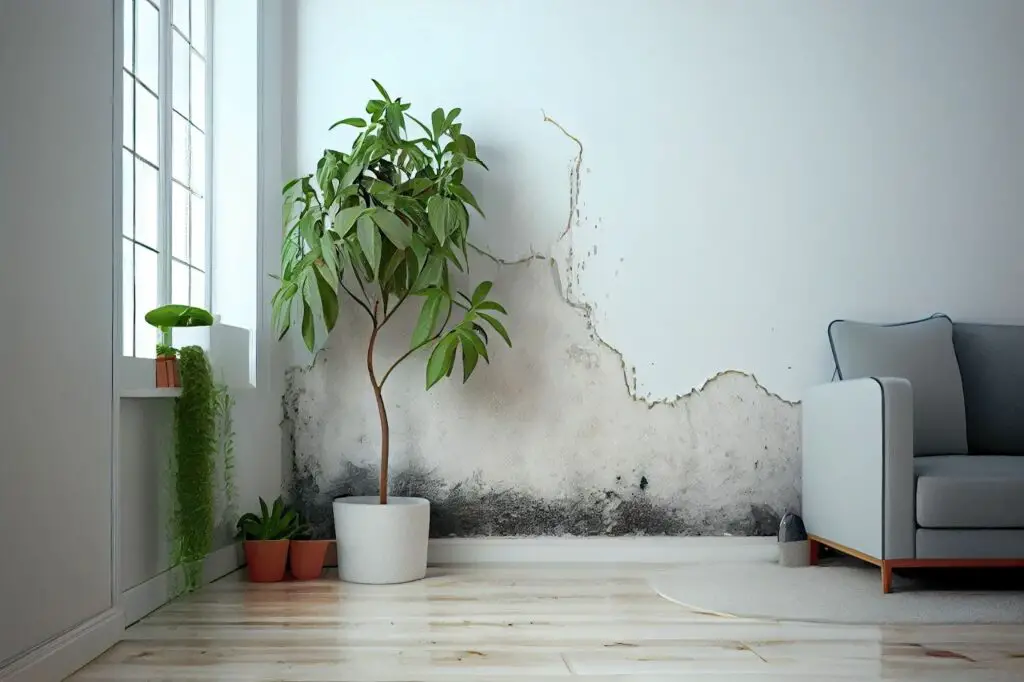
Ceilings often show the first signs of trouble when water leaks from above. Signs of water damage on a ceiling include dark, yellow, or brown stains forming in irregular shapes. In more severe cases, ceiling materials may sag or crack, indicating that water has weakened the structure.
Either way, the key point is that water damage is often out of sight long before it becomes visible, which is why early detection is so important.
Next, let’s take a look at how to identify ceiling and wall water damage in more detail.
Signs of Water Damage on Ceiling | What to Look For
A ceiling can tell you a lot about what’s happening above it – especially when it comes to water damage. If you notice something unusual, it’s never a good idea to brush it off as harmless. Signs of water damage on the ceiling can indicate anything from a minor, easily fixable plumbing issue to a potentially disastrous roof leak that could ruin the structure of your home.
Staining
One of the biggest signs of water damage on the ceiling is staining. Yellow, brown, or dark patches spreading across the ceiling often indicate slow moisture buildup. Unlike a fresh spill, these stains tend to grow over time rather than disappear quickly, which would indicate an ongoing problem.
If the ceiling begins to sag or bubble, that’s a sign the material has absorbed an alarming amount of water, weakening its general strength and integrity. In severe cases, sections may even start to crumble.
Cracks & Separations
Other signs of water damage on a ceiling are cracks or separation at the seams. Drywall and plaster ceilings naturally shift over time, but if you see new gaps forming – especially in areas with stains – moisture could be seeping in and slowly breaking down the material. Again, the sudden appearance of peeling paint is another clue that water is stubbornly pushing its way through.
Strange Noises
In some cases, the problem isn’t necessarily visible but audible. A faint dripping sound inside the ceiling may indicate an active water leak at home, even if no water is visible yet. If ignored for too long, the water might eventually break through, leading to a severe leak.
Since water damage on a ceiling often comes from above, the source isn’t always too obvious. The most telling signs of water damage on ceilings are a leaky pipe, a roofing issue, or condensation buildup. Either way, identifying the cause early will usually prevent horrendous structural repairs and mold growth in the future.
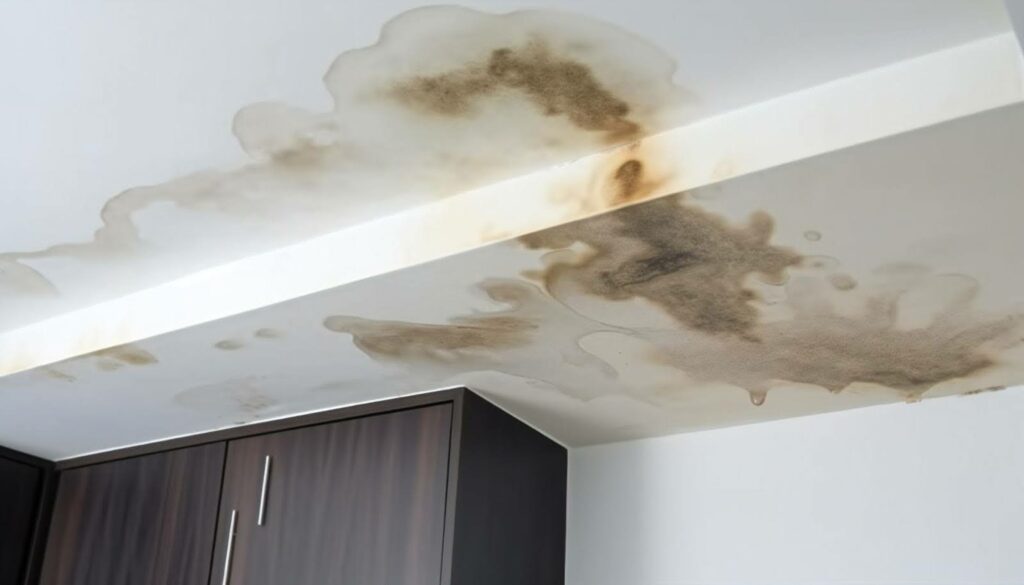
Signs of Water Damage in Walls: Hidden Issues
Unlike ceiling leaks, which often reveal themselves with more obvious, visible stains, the various signs of water damage in walls can remain hidden from view for months or even years. The problem usually starts behind drywall, inside insulation, or within structural framing, only revealing itself when the damage has become worse.
Because of its more hidden nature, you may need to think outside the box a little in order to identify the signs of water damage in walls. Here’s how to do that:
Water Bill
One of the biggest, if not surprising, signs of water damage in walls is an unexplained increase in your water bill. If your home’s water usage hasn’t changed, but the bill keeps climbing upwards, there is a reasonable chance that a hidden water leak is at play. Small drips from supply lines or slow leaks from aging plumbing can silently cause chaos behind walls long before you see a drop of water.
Warping Drywall
Another warning sign of water damage in walls relates to soft, swollen, or warped drywall. If pressing on a wall feels even remotely spongy or gives way under light pressure, moisture has probably weakened the material. In some cases, baseboards may even begin to separate, or paint might crack along edges as the drywall starts to expand.
Electrical Problems
In addition to the usual visual and physical clues, electrical issues can also indicate water damage in walls. Flickering lights, outlets that suddenly stop working, or unexpected breaker trips might indicate that moisture has reached the wiring, which would be a serious safety concern in most cases.
Mold Growth
If you notice a nasty, musty odor (even after cleaning), mold could be growing behind the drywall. Mold tends to thrive in damp, dark places, so hidden water damage is the perfect playground for mold growth on walls. While not one of the early signs of water damage in walls, mold growth is a firm indicator that a problem persists.
Diagnosing the Source of Water Damage
Of course, it goes without saying that finding the source of water damage is just as important as repairing it. Fixing visible water damage issues without addressing the root cause will only invite recurring problems. The challenge, however, is that water doesn’t always stay in one place. For example, a water damage stain on the ceiling could mean a leak from a bathroom upstairs, a roof issue, or even a problem with an HVAC system. Here’s how to identify the exact origin and stop the damage in its tracks:
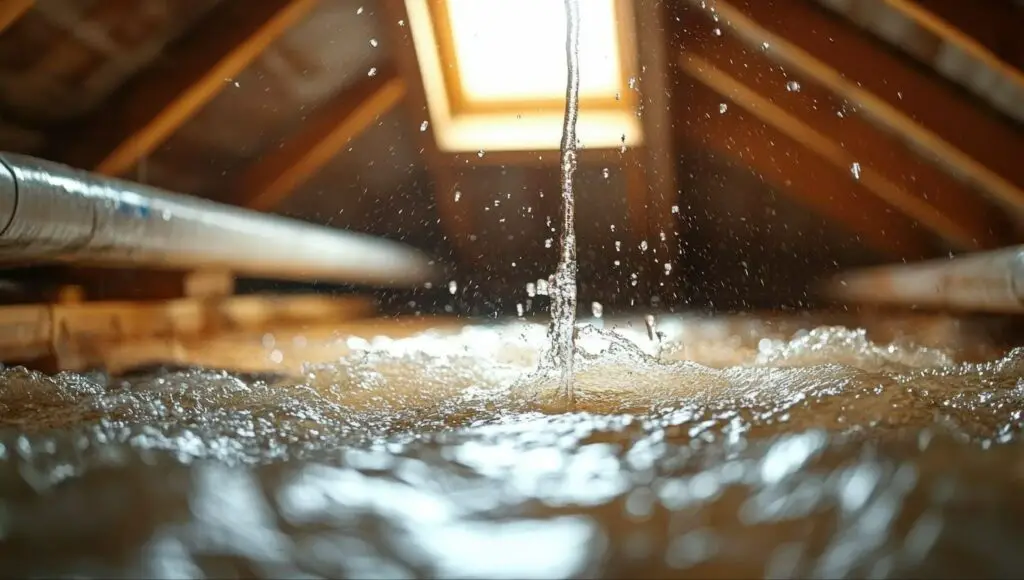
Checking for Roof Leaks
If you notice signs of water damage on the ceiling, especially after a heavy storm, the leading culprit is the roof. Carefully head to the attic armed with a strong flashlight and look for damp insulation, water trails, or (the biggest sign of all) daylight peeking through gaps. Pay special attention to areas around chimneys, vents, and skylights, as these are the common trouble spots.
Inspecting Plumbing and Appliances
When signs of water damage in walls and ceilings appear near kitchens, bathrooms, or laundry areas, the problem stems from faulty or damaged plumbing. Check under all sinks, behind every toilet, and around appliances like dishwashers and washing machines for leaks. A slow drip might not seem like much initially, but over time, it could saturate and lead to various types of mold on the drywall, which is, as always, a dreaded occurrence best avoided early.
Looking for Exterior Entry Points
Sometimes, water damage isn’t from inside the home. It can also seep in from the outside. Cracks in the foundation, gaps around windows (even tiny gaps), or poorly sealed siding can invite moisture to slowly infiltrate walls and ceilings. If the damage is near an exterior wall, you may wish to check for pooling water outside, clogged gutters, or deteriorating caulking.
Using Moisture Meters and Thermal Imaging
For those hard-to-spot leaks, moisture meters and infrared cameras can detect hidden dampness behind walls almost immediately. If you are struggling to locate the source, a water damage professional like Wet Rest can use the latest tools and equipment to quickly locate the issue before it causes structural damage.
The Repair Process of Fixing Water Damage in Walls and Ceilings
Once the source of water damage has been identified and stopped, the real work can commence. You may believe that repairing signs of water damage on the ceiling or signs of water damage in walls involves simple cosmetic fixes, but on the contrary, it requires a structured, careful approach to prevent further issues like mold growth or structural weakening.
Step 1: Stop the Water at the Source
The first priority before any repairs can start is stopping the water leak. If the damage is caused by plumbing, you first need to shut off the water supply. If a roof leak is the culprit, a temporary tarp or sealant may be necessary until a water damage company can make permanent repairs. A water pump will remove idle water, although you can remove water without a water pump quite easily by mopping and siphoning.
Step 2: Dry Everything Out
Moisture left behind can cause further damage, so drying is an important step. Use dehumidifiers for water-damaged rooms (or fans, if you don’t have one) before ensuring good ventilation to remove dampness from walls, ceilings, and floors. This step can also help prevent early signs of water damage in walls from worsening.
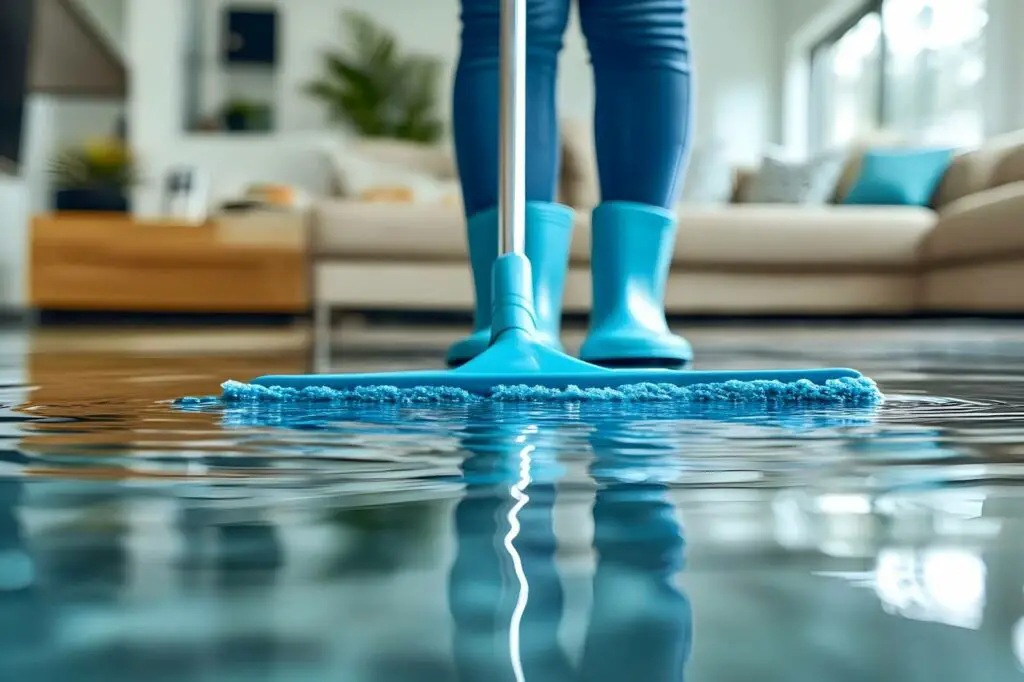
Step 3: Remove Damaged Materials
Drywall that has softened, bubbled, or crumbled should be cut out and replaced. The same goes for water-damaged insulation to prevent mold from spreading. If signs of water damage on the ceiling include sagging or cracking, some of the drywall might need suitable reinforcement (or even full replacement).
Step 4: Repair and Restore
Once everything is dry, the repairs can start. This means sealing all leaks, replacing any affected drywall, repainting, and reinstalling all removed fixtures. If mold has taken hold or the damage is particularly bad, professional restoration services are often the best option to ensure the problem is fully resolved.
Preventing Future Water Damage: Tips for Homeowners
For the most part, avoiding signs of water damage in walls or ceilings begins with disciplined, regular maintenance and a few preventive measures.
- Check Your Roof Regularly: Small leaks from missing shingles or cracked flashing can go unnoticed until they cause water damage inside your home. Annual inspections help catch problems early.
- Maintain Gutters and Downspouts: Clogged gutters push water toward your roof and walls, leading to leaks. Clean them out seasonally to prevent overflow.
- Seal Cracks and Openings: Small gaps around windows, doors, or foundation walls allow moisture to creep in. Use caulk or weatherproof sealant to keep water out.
- Monitor Indoor Humidity: Too much moisture inside creates the perfect environment for mold and mildew. Use exhaust fans in humid rooms like bathrooms and basements.
- Install Water Leak Detectors: Smart sensors can alert you to leaks before early signs of water damage in walls become costly problems.
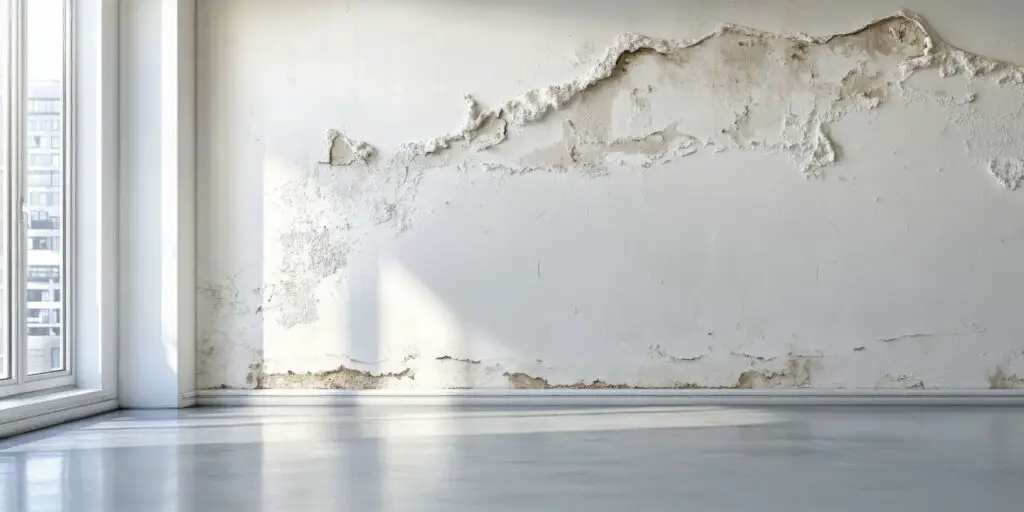
Bottom Line
Catching the early signs of water damage in walls or the ceiling before they become worse will save you time, money, and a great deal of stress. While small stains or soft drywall might seem like minor issues, they often indicate deeper structural issues – and that’s going to cost you a serious amount of money.
If you’ve noticed signs of water damage at home, don’t hesitate to take action. Acting now can prevent a far bigger headache later. Contact Wet Reset for expert assessment and professional water damage restoration services.

